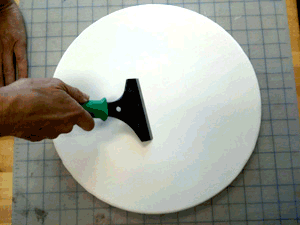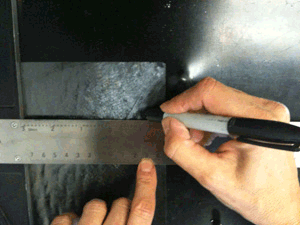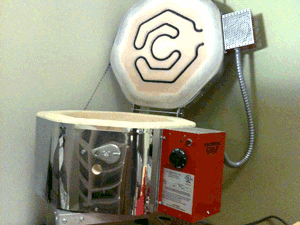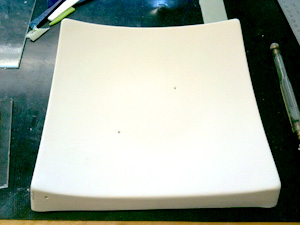
1) Preparing the Kiln Shelf

Scrape off any leftover kiln wash from your shelf that may be leftover from past firings. This will ensure a nice smooth surface for when you fuse your project.
Prepare your kiln wash by mixing the kiln wash powder with the recommended amount of water. Each manufacturer varies, but it is usually about 5 parts water per part kiln wash.
Using a "haike" brush, gently apply the kiln wash in a thin layer across your shelf. You should brush in one direction rather than going back and forth. Apply at least four coats and let dry completely.
2) Cutting the Glass

Measure amd mark your glass to the size that you desire for your project. Before cutting it is important to make sure that your work surface is level, clean, stable, and comfortable for you to reach. It is also a good idea to invest in a good glass cutter made specifically for glass fusion. Wearing safety goggles, and doing your best to not let the cutter blade tilt to once side more than the other, score along your desired cut with even pressure and a single motion. The objective is to apply enough pressure to only have to cut the glass once, but not so hard that your glass slivers.
Once your glass is scored, you will break the the cut. You can do this using glass cutter pliers or by gently tapping along the back of the score with the opposite side of your glass cutter.
3) Design

Now for the fun part! Using the pieces you've cut, create a design for your project. You can layer clear glass on top to add depth to the glass below, as well as smaller piece son top to add more texture. Note that pieces that are layered closer to the edges of the project may push the sides out as they melt. The glass available for glass fusion is infinite. Colors, finishes and textures are just a few things to consider. As you fuse more and work with more glass you will learn what works with what and maybe even discover a few tricks of your own. Experimentation is one of the best parts of glass fusion.
4) Fusing

Glass fusing is the process of using a kiln to join together pieces of glass. If you apply heat to glass, it will soften. If you continue to apply heat, the glass will become more fluid and flow together. Two or more pieces of glass will stick (or "fuse") to each other. When the right kind of glass is heated and then cooled properly, the resulting fused glass piece will be solid and unbroken.
5) Slumping

Many people also use the word "fusing" to include bending and shaping glass using the heat of a kiln. This manipulation can take many forms, but the most common is slumping, where a mold is used to cause already fused glass to take on the shape of a bowl, a plate, or similar object. Other kinds of manipulation done with fusing techniques are combing, which involves using a tool to distort the shape of the glass while it is hot, and fire polishing, which uses a kiln to heat the glass just enough to make it shiny and smooth.

We’d love to hear from you! Feel free to contact the 1500 Degrees team.
Contact Us >>
